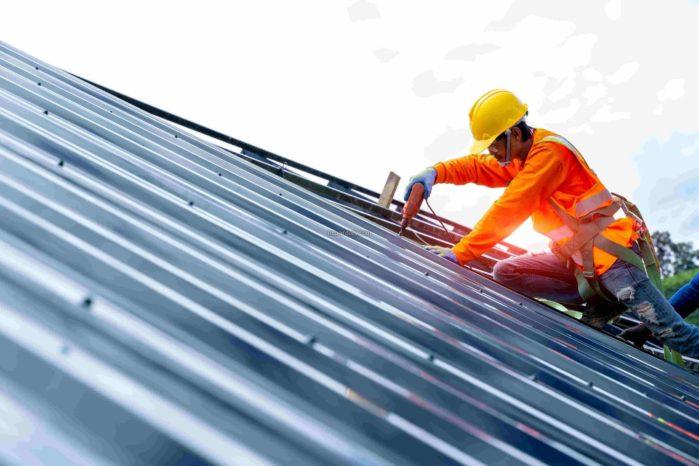
When it comes to roof repairs, many people are unaware of the environmental considerations involved. When done incorrectly, roof repair projects can significantly impact the environment. Understanding the ecological side of roof repair is important for homeowners who want to maximize their investment and protect the environment.
This article will explain why it is important to consider environmental factors when performing roof repairs. We will also provide tips on how you can ensure that your roof repair projects are in an environmentally friendly manner. By understanding and implementing these ideas, you can keep your home safe and protect the environment simultaneously.

Environmental Impact of Traditional Techniques
The materials used in traditional roof repair techniques are hazardous to the environment. As asphalt shingles get installed, dangerous fumes and particles get released into the atmosphere.
As a result of these chemicals, air pollution and ozone depletion can become a problem in the environment. Moreover, many of these materials require professional disposal at their end of life, increasing landfill waste. One of the major contributors to landfills is excess waste generated by traditional roof repairs, which can result in soil erosion and water contamination. It is also possible for asphalt shingles to leak toxic pollutants into the ground and contaminate local water supplies.
The development of eco-friendly roof repair methods along with traditional methods occurred over the years. Among these are recycled rubber shingles, metal roofs, and green roofs made from natural materials. Compared to traditional repairs, these types can have a significantly smaller environmental impact.
Understanding New Techniques
As more and more homeowners become aware of the environmental impact of their home repairs, they are choosing to invest in sustainable roof repair materials. We explore a few of the techniques for a sustainable roofing approach;
Metal roofing
These roofs have come a long way since their introduction over a century ago. Today’s metal roofs have technological enhancements that make them highly durable, waterproof, and energy efficient. Metal roofs also feature reflective coatings that can deflect solar radiation away from the home to increase energy efficiency further.
Rubberized asphalt
Another popular sustainable material that offers durability and flexibility. These recyclable roofs come with steep slope applications where traditional materials may not hold up. Another advantage of rubberized asphalt is its resistance to hail and wind damage, which makes it a great choice for those looking for long-term protection from the elements.
Composite shingles
They are also becoming increasingly popular as an environmentally friendly solution for roof repair. These products contain recycled content from plastic, rubber, or paper and can last significantly longer than traditional asphalt shingles. Composite shingle roofs are energy efficient because they reflect the hot summer sun away from home and insulate against cold winter temperatures.
Clay tiles & slate
Finally, clay tiles and slate are two of the oldest roofing materials available, with some roofs made from these materials surviving centuries. Clay tiles and slate are much more resilient than traditional asphalt shingles and can withstand extreme weather conditions like hail and high winds. They also provide superior insulation values that can reduce energy expenses over time.
Green and Cool Roofing
The use of cool and green roofing has been used for decades to reduce energy consumption and increase the sustainability of buildings. White or silver roofing materials reflect sunlight and help lower a building’s interior temperature by reflecting sunlight. Rooftop gardens with vegetation are known as green roofing systems. Urban systems like these absorb solar heat, improve air quality, reduce stormwater runoff, provide insulation and soundproofing, and improve biodiversity.
Reducing the Environmental Impact Through Design
When conducting roof repair, make sure to use the right design and materials to help reduce the environmental impact of a project. For example, opting for lightweight materials such as steel or aluminum that require less energy to transport can significantly lessen the carbon footprint associated with a project. Using recycled materials in repairs can also be beneficial.
Furthermore, designs that reflect natural elements like light and air flow can decrease energy demands for cooling and heating by utilizing natural resources more efficiently. Overall, being mindful of design considerations is an essential part of reducing the environmental impact of any roof repair project.
Taking 2 R’s As A Sustainable Roofing Approach
When deciding what type of material to use for roof repairs, several options are available that are better for the environment. One of the most important considerations is to look for materials certified as energy-efficient and produced using sustainable practices. Recycled material is also an excellent option, as it helps reduce waste and keep valuable resources out of landfills. Additionally, looking for materials with a high “R” value (a measure of thermal resistance) can help improve the effectiveness of insulation and reduce energy costs over time.
It is also important to consider the material’s durability when selecting. Opting for more robust options like metal or slate can help extend the life of a roof, reducing the need to conduct frequent repairs in the future. Last but not least, researching local regulations on roofing materials before any repair work can help ensure that the selected materials comply with all relevant environmental standards.
Conclusion
Sustainable roofing materials such as metal, composites, rubberized asphalt, clay tiles, and slate offer numerous advantages over traditional materials like asphalt shingles. These materials are made from recycled content or renewable sources and can help reduce energy use during the installation and improve insulation values for lasting protection against the elements.
When done right, the roof repairing process can be environmentally friendly. By using certified energy-efficient materials and recycled products, reducing energy demands with natural elements, and selecting durable roofing materials that comply with all relevant environmental regulations, homeowners can make responsible decisions regarding their roof repairs. For making environmentally conscious choices about how to repair a roof, it’s important to research the best available options.
